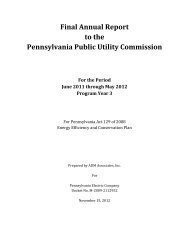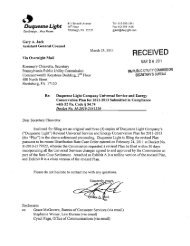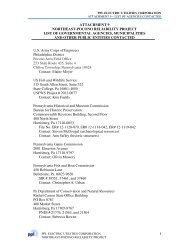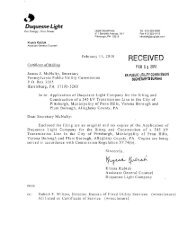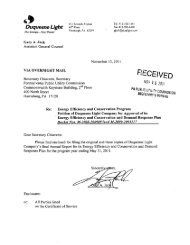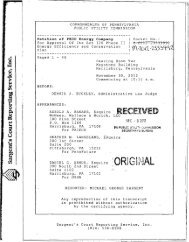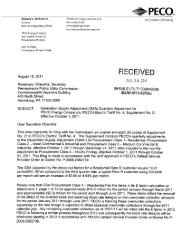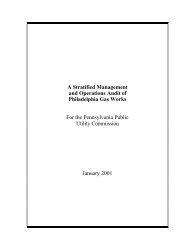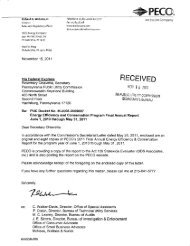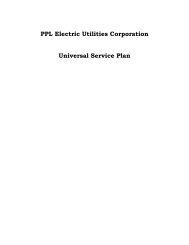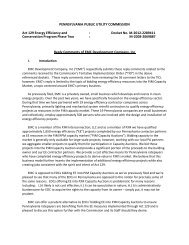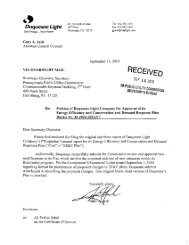2009 Report - Pennsylvania Public Utility Commission
2009 Report - Pennsylvania Public Utility Commission
2009 Report - Pennsylvania Public Utility Commission
Create successful ePaper yourself
Turn your PDF publications into a flip-book with our unique Google optimized e-Paper software.
power from the wholesale market to fulfill their provider of last resort (POLR)<br />
obligations. 15<br />
It is the responsibility of each load-serving entity to make provisions for<br />
adequate generating resources to serve its customers. Furthermore, section<br />
2807(e)(3) of the <strong>Public</strong> <strong>Utility</strong> Code requires that, at the end of the transition<br />
period (the period in which the EDC recovers its stranded costs), the local EDC or<br />
<strong>Commission</strong>-approved alternate supplier must acquire electric energy, pursuant to<br />
a <strong>Commission</strong>-approved competitive procurement process, for customers who<br />
contract for power which is not delivered, or for customers who do not choose an<br />
alternate supplier. The acquired electric power must include a prudent mix of spot<br />
market purchases, short-term contracts and long-term purchase contracts,<br />
designed to ensure adequate and reliable service at the least cost to customers<br />
over time. EDCs must also assume the role of provider of last resort for customers<br />
choosing to return to the EDC. 16<br />
On May 10, 2007, the <strong>Commission</strong> finalized the statewide default service<br />
rulemaking and policy statement which provides guidelines to default service<br />
providers regarding the acquisition of electric generation supply, the recovery of<br />
associated costs and the integration of default service with competitive retail<br />
electric markets. The regulations establish the criteria on how electric generation<br />
service is provided to customers who choose to obtain generation service from an<br />
alternate supplier. In reviewing the comments and considering revisions to the<br />
proposed default service rules, the <strong>Commission</strong> recognized that some elements of<br />
the default service rules should be addressed in a policy statement that provides<br />
guidance to the industry rather than strict rules. 17<br />
Alternative Energy Portfolio Standards<br />
18<br />
Act 213 requires that an annually increasing percentage of electricity sold<br />
to retail customers be derived from alternative energy resources. This applies to<br />
both electric distribution companies and electric generation suppliers.<br />
These alternative energy resources are categorized as Tier 1 and Tier 2<br />
resources. Tier 1 resources include solar, wind, low-impact hydropower,<br />
geothermal, biologically derived methane gas, fuel cells, biomass and coal mine<br />
methane. Tier 2 resources include waste coal, demand side management,<br />
distributed generation, large-scale hydropower, by-products of wood pulping and<br />
15 Also referred to as “obligation to serve” and “default service.”<br />
16 66 Pa.C.S. § 2807(e)(3).<br />
17 Docket Nos. L-00040169 and M-0007<strong>2009</strong>; 52 Pa. Code §§ 54.4-54.6, 54.31-54.41, 54.123, 54.181-54.189, 57.178<br />
and 69.1801-68.1817.<br />
18 73 P.S. §§ 1647.1–1647.8.<br />
Electric Power Outlook for <strong>Pennsylvania</strong> 2008-2013 13




